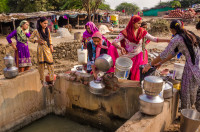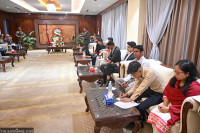Opinion
CSOs in a loktantrik Nepal
A democratic polity should look for ways to further allow Nepali citizens to fully enjoy their fundamental right to organise
Pratyoush Onta & Avash Bhandari
Civil society organisations (CSOs) and non-governmental organisations (NGOs) started to truly flourish in Nepal only after the end of the partyless Panchayat system and autocratic monarchy following Jana Andolan I in 1990. It was the democratic constitution of Nepal 1990 that fully recognised the fundamental rights of Nepali citizens to organise and form associations and their right to freedom of thought and expression.
The formalisation and institutionalisation of nongovernmental or social organisations in Nepal began with the promulgation of the Societies Registration Act in 1959. The Societies Registration Act was replaced by the Associations Registration Act of 1977. According to Diwakar Chand, a key figure in the development of NGOs in Nepal, this Act “made further provision to even develop social organisation aimed towards the upliftment of religious, cultural, physical and professional activities as well” (quoted from his 1991 book Development through Non-Governmental Organizations in Nepal). However, it should be noted that such provision to develop was limited by the Panchayat regime’s obsession with control and coordination, which did not allow civic organisations to flourish independently. Despite guaranteeing the right to property, freedom of speech and expression and freedom to assemble peacefully without arms, the Panchayat constitution promulgated in 1962 did not guarantee the right to form unions and associations, which was included only after its first amendment in 1967. Moreover, the ‘sake of public good’ was presented as a raison d’être to impose several restrictions on the exercise of fundamental rights.
A national workshop of social workers was organised in Kathmandu in 1977 which called for the establishment of a national body for ‘regulating’ NGOs and their programmes in Nepal. This paved the way for the promulgation of the Social Service National Coordination Act of 1977. This Act defined Social Service National Coordination Council (SSNCC) as “a national level autonomous corporate body with perpetual succession bestowed with the authority to purchase, sell, acquire, raise loan and accept grant assistance and gifts” (as mentioned by Chand). On 13 February 1977, Social Service National Service Committee was formed under the chairmanship of then Queen Aishwarya and included six subcommittees: Health Service, Handicapped Service, Child Welfare, Youth Activities, Community Service, and Women Service Coordination Committee. The Handicapped Service Coordination Committee was later merged with Health Service and a new Hindu Religion Coordination Committee came into force in 1985. In practice, the Act also made it mandatory for all organisations to come under one of the subcommittees.
Layers of policing
With Queen Aishwarya as a chair, the SSNCC emerged as a powerful ‘umbrella organisation’ with authority to coordinate NGO activities and mediate relationship between the NGOs, the government, and international aid agencies. Furthermore, the preamble of the Act identified “to maintain uniformity and harmonization in the national, foreign and international grants and assistance being received in and by the social organization” as one of the key functions of the Council, which essentially meant that no organisation could survive, let alone thrive, without the good will of the SSNCC headed by the Queen.
All organisations also had to be formally registered at the Council to be eligible for funds and foreign NGOs that sought to help NGOs in Nepal had to first reach an agreement with the Council. SSNCC even made a provision that all funds going into the NGO sector had to be channelised through the Council, purportedly with the aim “to try to mobilize new resources in addition to the management and allocation of already available resources for social welfare activities” and “to try to bring uniformity and coordination in the financial contribution of national, foreign, and INGOs or foreign countries to channelize funds received in accordance with such agreement or contracts to respective social organizations” (as mentioned by Chand). The move to enforce financial discipline was essentially a ploy to keep NGOs’ independence in check, consistent with the ethos of ‘guided democracy’ of the Panchayat system. Interestingly, in “A Brief Introduction to Social Service National Coordination Council” published by the SSNCC itself, ‘surveillance and counseling to the institutions’ was listed as one of its objectives.
Rather than relating the growth of NGOs to the fundamental right of citizens to organise, the SSNCC saw NGOs as a mechanism to promote national development and social services. As Bishwa Keshar Maskay put it in his 1998 book Non-Governmental Organizations in Development: Search for a New Vision, “NGOs were treated in the image of a viable and dependable mechanism for providing social services to the poor, the marginalized and the disadvantaged communities.” Notably, all this had to be done under the close control of the Council and within the overall framework of the autocratic political system. Later, a ministry was also formed in 1982—the Ministry of Labour and Social Welfare—to supervise activities related to social services, thus adding another layer of policing of NGOs.
Terms like ‘uniformity’, ‘coordination’, and ‘avoiding duplication’ were constantly used in policy documents and Acts related to CSOs and NGOs during the Panchayat regime. All this fit perfectly well with the core values of that regime. Political parties were banned under the system. Similarly, there was no competition regarding the ultimate leader of the country, the King. The Panchayat state also sought to be all-pervasive and all-encompassing because it did not recognise the independence of civil society. Finally, the regime also craved cultural uniformity. In such political context, it was only obvious that any Acts concerning CSOs/NGOs and their relative autonomy were overridden by the excessive desire on behalf of the state to control under the guise of coordination, eliminate competition in the name of ‘avoiding duplication’, and get rid of diversity while seeking uniformity.
Throwback to pre-1990 era
After the demise of the Panchayat system, the SSNCC was rechristened as Social Welfare Council (SWC), following the promulgation of the Social Welfare Act of 1992. The Associations Registration Act, however, did not draw any attention from the post-1990 governments and still continues to structure not just the registration but also the function of NGOs in Nepal. In post-Panchayat Nepal, nobody seems to have had the time to stop and ask if a re-named child of the erstwhile repressive regime was fit for a supposedly democratic polity.
Democracy thrives in competition, diversity and autonomy of institutions, and these characteristics are prerequisites for any vibrant civil society. It is reasonable to ‘avoid duplication’ when it comes to building taps, toilets, or even schools in particular parts of the country, and these activities might also require some coordination with local bodies. However, the same logic cannot be applied to NGOs that work in the field of promoting civil and political rights, advocacy and knowledge production. Just as in the political arena occupied by competitive political parties and the journalism sector constituted by competing media houses, a fair amount of competition is beneficial in these NGO sub-sectors to improve the value of their ‘end products’, whether they are academic or para-academic publications or the promotion of different mechanisms to increase, for example, access to justice of some marginalised groups. Competing ideas and practices are the core building blocks of a loktantrik framework.
Current NGO bashings in Nepal have completely failed to understand this basic idea. In making sweeping calls for enhanced regulation of NGOs, these advocates have failed to acknowledge the actually existing diversity within CSOs/NGOs in terms of their work. They have also failed to appreciate the value of this diversity to the loktantrik polity we have adopted constitutionally. Instead their calls for enhanced regulation are a throwback to the ‘coordination’ mindset of the pre-1990 era. Their calls for greater regulation barely mask the desire to control Nepali NGOs through various state apparatuses.
In a loktantrik polity, the rights-oriented, advocacy and academic NGOs are manifestations of the Nepali citizens’ fundamental right to organise and equally fundamental right to the freedom of thought and expression. Controlling these rights in the name of ‘coordination’, ‘avoiding duplication’ and ‘uniformity’ suited the partyless Panchayat system. However, they are completely out of place in a loktantrik set-up. Instead, the loktantrik polity should look for ways that will further allow Nepali citizens to fully enjoy their fundamental right to organise in the form of CSOs/NGOs.
Onta and Bhandari are researchers at Martin Chautari, a non-profit organisation based in Kathmandu




 19.12°C Kathmandu
19.12°C Kathmandu











